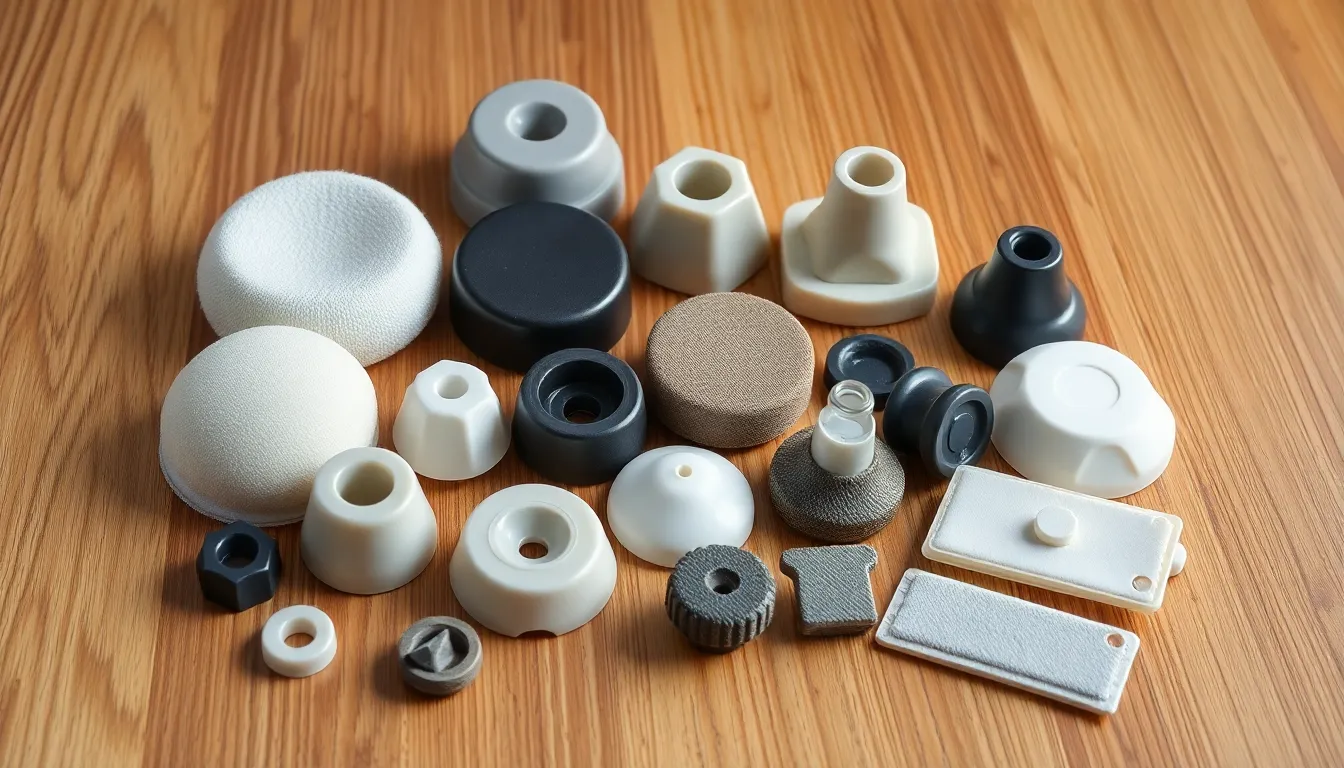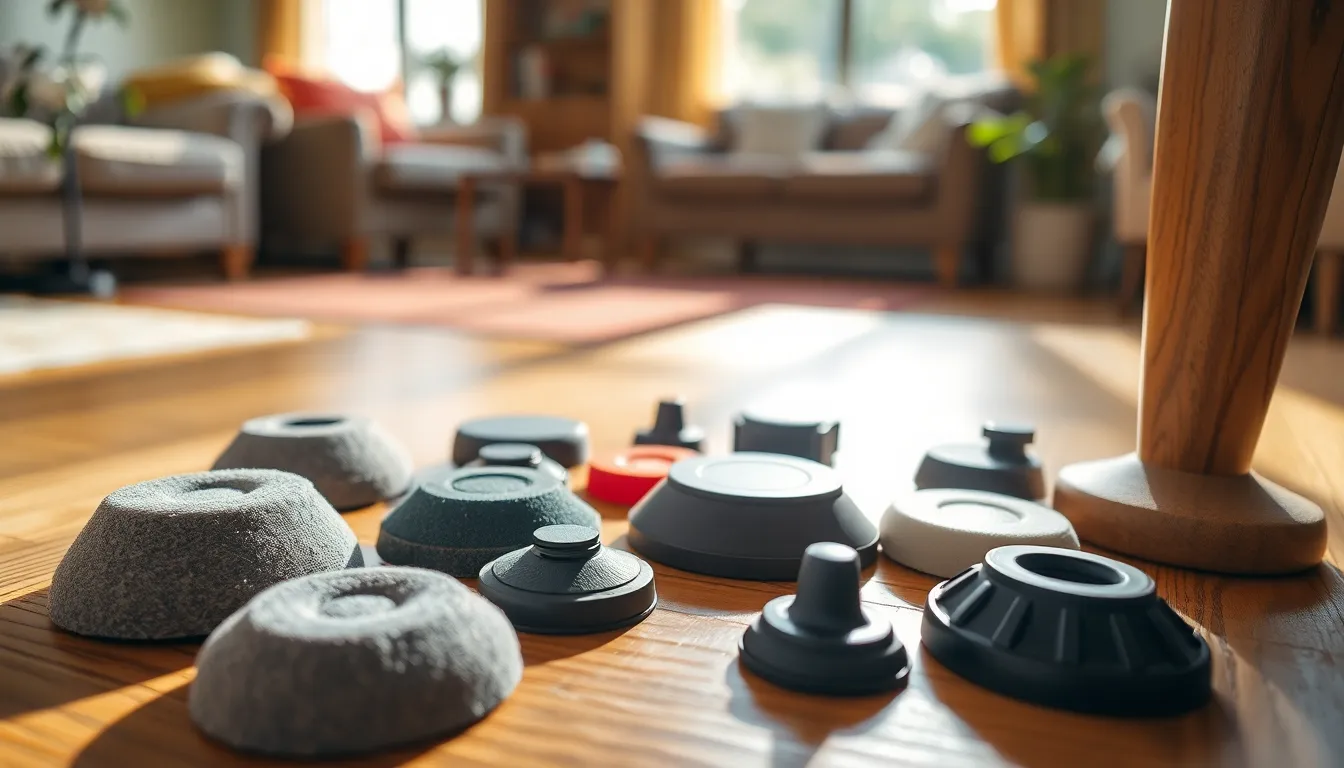Table of Contents
ToggleEvery home has that one piece of furniture that seems to have a vendetta against the floor. Whether it’s the dining room table that leaves scratches like a cat on a scratching post or the couch that plays a game of “let’s see how many dents we can create,” furniture leg protectors are the unsung heroes of home decor. They’re like tiny bodyguards for your beloved furniture, ready to save the day from unsightly damage.
Overview of Furniture Leg Protectors
Furniture leg protectors serve a vital role in maintaining the integrity of floors. These protectors minimize scratching and denting caused by heavy furniture pieces. Multiple types of protectors exist, including felt pads, rubber caps, and glides. Felt pads adhere to the bottom of furniture legs and provide a soft surface that glides smoothly on floors. Rubber caps offer a secure grip while preventing slips and marks.
Picking the correct type of protector depends on the flooring material. For hardwood floors, felt pads are ideal as they reduce friction. In contrast, rubber caps work well on tile or laminate surfaces, offering stability. Installation methods vary; some protectors stick while others fit over leg ends. Choosing the right option ensures effective protection against damage.
Consider the size and weight of the furniture when selecting protectors. Lightweight items can often use smaller felt pads, while larger furniture requires robust protectors for maximum support. Each protector type also offers different benefits in terms of style and aesthetic appeal. Many options come in various colors and designs to complement existing décor.
Monitoring weather conditions impacts the performance of certain protectors. Increased moisture may affect adhesion, while drier conditions can enhance the effectiveness of rubber caps. Regularly inspecting furniture leg protectors for wear can help sustain their protective qualities. By investing in high-quality protectors, homeowners ensure their furniture remains intact while preserving floor surfaces for the long term.
Types of Furniture Leg Protectors

Furniture leg protectors come in various types, each designed for specific applications. Understanding these options helps homeowners select the best fit for their needs.
Soft Pads
Soft pads, often made from felt, provide a protective layer between furniture legs and flooring. These pads effectively reduce friction, making them ideal for hardwood and laminate surfaces. Different sizes and shapes accommodate various furniture legs, ensuring a secure fit. Available in adhesive-back options, soft pads easy to apply and replace as needed. Regular inspection ensures they maintain their functionality over time.
Hard Caps
Hard caps, typically constructed from durable materials like rubber or plastic, offer robust protection for floors. They shield surfaces from dents and damage, ideal for heavier furniture, such as couches and tables. Compatible with a range of flooring types, hard caps provide stability and leverage. Easy to fit over furniture legs, these caps often feature a snug design to prevent slipping. They also resist wear and tear, making them a long-term solution for floor protection.
Adhesive Strips
Adhesive strips serve as a versatile option for protecting floors from furniture leg damage. Typically made from foam or rubber, these strips adhere directly to furniture legs, creating an additional protective barrier. Easy to apply, they contour to various leg shapes, ensuring a proper fit. Often used on uneven surfaces, adhesive strips can absorb shock and reduce movement. They require minimal maintenance and can be replaced when they wear down, ensuring continued effectiveness.
Benefits of Using Furniture Leg Protectors
Furniture leg protectors offer numerous advantages for maintaining both furniture and flooring. They play a crucial role in preventing floor damage and minimizing noise.
Preventing Floor Damage
Furniture leg protectors effectively shield floors from scratches and dents caused by heavy items. They create a buffer between the furniture leg and floor surface, reducing friction and impact. Using soft pads on hardwood floors prevents costly refinishing, while hard caps provide robust protection on various surfaces. Each protector matches specific furniture weight and type, ensuring enhanced durability. Regularly inspecting protectors also helps maintain optimal performance, allowing homeowners to prolong the life of their flooring.
Reducing Noise
Noise reduction significantly enhances comfort in homes. Furniture leg protectors minimize the sound produced when moving furniture, creating a quieter environment. Soft felt pads absorb vibrations, preventing scraping noises when chairs and tables slide across floors. Choosing the right protector ensures compatibility with different flooring types, further decreasing sound levels. Installing these protectors fosters a more enjoyable living space, making everyday activities less disruptive. Overall, they contribute to a peaceful atmosphere while protecting floors from damage.
How to Choose the Right Furniture Leg Protectors
Selecting the correct furniture leg protectors involves careful consideration of materials and size to ensure optimal protection for flooring.
Material Considerations
When evaluating furniture leg protectors, material plays a crucial role. Felt pads work well on hardwood floors, minimizing friction and preventing scratches. Rubber caps offer robust protection for tile or laminate surfaces, reducing sliding and improving stability. Plastic protectors cater to heavier furniture, standing up to significant wear and tear. Each material varies in durability and efficacy, so choosing one that matches the flooring type ensures effective performance. Additionally, adhesive strips made from foam or rubber provide versatility, adhering directly to furniture legs for added shock absorption.
Size and Fit
Size significantly impacts the effectiveness of furniture leg protectors. Each protector must align with the furniture leg dimensions for the best fit and protection. Smaller pads may not cover the entire surface area, leading to potential floor damage. Oversized protectors can be cumbersome, affecting the furniture’s balance. Measure furniture legs prior to selection to ensure an accurate fit. Various shapes, like round or square, allow for adjustments based on furniture design, enhancing both aesthetics and functionality. Ensuring the right size prevents unnecessary wear on floors and maintains furniture stability.
Installation Tips for Furniture Leg Protectors
Selecting the right tools for installation ensures optimal results. A clean surface greatly enhances adhesion. Begin by wiping the furniture legs thoroughly to eliminate dust and moisture. Dry surfaces allow for better grip, which maximizes protectors’ effectiveness.
For felt pads, remove the backing and press firmly onto the leg. Ensuring contact across the entire surface reduces the chances of slippage. Different shapes exist, so using the correct size for each leg height is vital for stability.
Rubber caps require a slightly varied process. Position the cap over the leg and push down until it fits snugly. Secure positioning prevents unexpected movements that could scratch the floor.
Adhesive strips function differently and can be a versatile choice. Peel the protective layer and affix the strip directly onto the leg, adjusting as needed for a proper fit. Regular checks ensure the adhesive remains intact, especially under heavier furniture.
Avoid common pitfalls during installation. Misalignment leads to uneven pressure, which could damage both the furniture and the floor underneath. Measuring legs prior to using hard caps or rubber protectors helps eliminate guesswork, ensuring a precise fit.
Lastly, inspect protectors periodically, as wear can diminish their effectiveness. By focusing on maintenance, furniture remains protected, and floors continue to look pristine over time. Following these installation tips will lead to prolonged durability and enhanced functionality of both furniture and flooring surfaces.
Investing in furniture leg protectors is a smart choice for anyone looking to maintain their flooring and extend the life of their furniture. These protectors not only prevent scratches and dents but also minimize noise, creating a more peaceful home environment. By selecting the right type and size, homeowners can ensure optimal protection that complements their décor.
Regular inspections and proper installation are key to maximizing the benefits of these protectors. With a variety of options available, including felt pads, rubber caps, and adhesive strips, there’s a solution for every piece of furniture and flooring type. Ultimately, utilizing furniture leg protectors is a proactive step toward preserving both furniture and floors for years to come.








